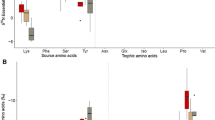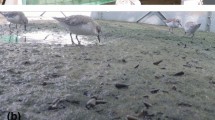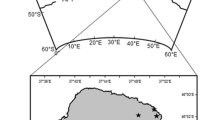Abstract
The use of stable isotopes to infer diet requires quantifying the relationship between diet and tissues and, in particular, knowing of how quickly isotopes turnover in different tissues and how isotopic concentrations of different food components change (discriminate) when incorporated into consumer tissues. We used feeding trials with wild-caught yellow-rumped warblers (Dendroica coronata) to determine δ15N and δ13C turnover rates for blood, δ15N and δ13C diet-tissue discrimination factors, and diet-tissue relationships for blood and feathers. After 3 weeks on a common diet, 36 warblers were assigned to one of four diets differing in the relative proportion of fruit and insects. Plasma half-life estimates ranged from 0.4 to 0.7 days for δ13C and from 0.5 to 1.7 days for δ15N . Half-life did not differ among diets. Whole blood half-life for δ13C ranged from 3.9 to 6.1 days. Yellow-rumped warbler tissues were enriched relative to diet by 1.7–3.6% for nitrogen isotopes and by −1.2 to 4.3% for carbon isotopes, depending on tissue and diet. Consistent with previous studies, feathers were the most enriched and whole blood and plasma were the least enriched or, in the case of carbon, slightly depleted relative to diet. In general, tissues were more enriched relative to diet for birds on diets with high percentages of insects. For all tissues, carbon and nitrogen isotope discrimination factors increased with carbon and nitrogen concentrations of diets. The isotopic signature of plasma increased linearly with the sum of the isotopic signature of the diet and the discrimination factor. Because the isotopic signature of tissues depends on both elemental concentration and isotopic signature of the diet, attempts to reconstruct diet from stable isotope signatures require use of mixing models that incorporate elemental concentration.




Similar content being viewed by others
References
Afik D, Karasov WH (1995) The trade-offs between digestion rate and efficiency in warblers and their ecological implications. Ecology 76:2247–2257
Ben-David M, Flynn RW, Schell DM (1997a) Annual and seasonal changes in diets of martens: evidence from stable isotopes analysis. Oecologia 111:280–291
Ben-David M, Hanley TA, Klein DR, Schell DM (1997b) Seasonal changes in diets of coastal and riverine mink: the role of spawning Pacific salmon. Can J Zool 75:803–811
Cerling TE, Harris JM (1999) Carbon isotope fractionation between diet and bioapatite in ungulate mammals and implications for ecological and paleontological studies. Oecologia 120:347–363
Chisholm BS, Nelson DE, Schwarcz HP (1982) Stable-carbon isotope ratios as a measure of marine versus terrestrial protein in ancient diets. Science 216:1131–1132
DeNiro MJ, Epstein S (1978) Influence of diet on the distribution of carbon isotopes in animals. Geochim Cosmochim Acta 42:495–506
DeNiro MJ, Epstein S (1981) Influence of diet on the distribution of nitrogen isotopes in animals. Geochim Cosmochim Acta 45:341–351
Gannes LZ, O'Brien DM, Martínez del Rio C (1997) Stable isotopes in animal ecology: assumptions, caveats, and a call for more laboratory experiments. Ecology 78:1271–1276
Gannes LZ, Martínez del Rio C, Koch P (1998) Natural abundance variations in stable isotopes and their potential uses in animal physiological ecology. Comp Biochem Physiol 119A:725–737
Hilderbrand G V, Farley SD, Robbins CT, Hanley TA, Titus K, Servheen C (1996) Use of stable isotopes to determine diets of living and extinct bears. Can J Zool 74:2080–2088
Hobson KA (1987) Use of stable-carbon isotope analysis to estimate marine and terrestrial protein content in gull diets. Can J Zool 65:1210–1213
Hobson KA, Clark RG (1992a) Assessing avian diets using stable isotopes I: turnover of 13C in tissues. Condor 94:181–188
Hobson KA, Clark RG (1992b) Assessing avian diets using stable isotopes II: factors influencing diet-tissue fractionation. Condor 94:189–197
Hobson KA, Clark RG (1993) Turnover of 13C in cellular and plasma fractions of blood: implications for nondestructive sampling in avian dietary studies. Auk 110:638–641
Hobson KA, Piatt JF, Pitochelli J, (1994) Using stable isotopes to determine seabird trophic relationships. J Animal Ecol 63:786-798
Hobson KA, Schell DM, Renoug D, Noseworthy E (1996) Stable carbon and nitrogen isotopic fractionation between diet and tissues of captive seals: implications for dietary reconstructions involving marine mammals. Can J Fish Aquat Sci. 53:528–533
Kelly JF (2000) Stable isotopes of carbon and nitrogen in the study of avian and mammalian trophic ecology. Can J Zool 78:1–27
Klasing KC (1998) Comparative Avian Nutrition. CAB International, Wallingford, UK
Kline TC Jr., Goering JJ, Mathisen OA, Poe PH, Parker PL, Scalan RS (1993) Recycling of elements transported upstream by runs of Pacific Salmon. II. δ15N and δ13C evidence in Kvichak River watershed, Bristol Bay, southwestern Alaska. Can J Fish Aquat Sci 50:2350–2365
Levey DJ, Karasov WH (1994) Gut passage of insects by European starlings and comparison with other species. Auk 111:478–481
Levey DJ, Martínez del Rio C (2001) It takes guts (and more) to eat fruit: lessons from avian nutritional ecology. Auk 118:819–831
Macko SA, Fogel M., Engel MH, Hare PE (1986) Kinetic fractionation of stable nitrogen isotopes during amino acid transamination. Geochim Cosmochim Acta 50:2143–2146.
Martin AC, Zim HS, Nelson AL (1951) American wildlife and plants: A guide to wildlife food habits. Dover, New York
Mizutani H, Kabaya Y, Wada E (1991) Nitrogen and carbon isotope compositions relate linearly in cormorant tissues and its diet. Isotopenpraxis 27:166–168
Mizutani H, Fukuda M, Kabaya Y (1992) 13C and 15N enrichment factors of feathers of 11 species of adult birds. Ecology 13:1391–1395
O'Brien DM, Schrag DP, Martinez del Rio C (2000) Allocation to reproduction in a hawkmoth: a quantitative analysis using stable isotopes. Ecology 81:2822–2831.
Owens NJP (1987) Natural variations in 15N in the marine environment. Adv Mar Biol 24:389–451
Peterson BJ, Fry B (1987) Stable isotopes in ecosystem studies. Annu Rev Ecol Syst 18:293–320
Phillips DL (2001) Mixing models in analysis of diet using multiple stable isotopes: a critique. Oecologia 127:166–170.
Phillips DL, Koch PL (2002) Incorporating concentration dependence in stable isotope mixing models. Oecologia 130:114–125
Pyle P (1997) Identification guide to North American birds: Part I Columbidae to Ploceidae. Slate Creek Press, Bolinas, Calif.
Romanek CS, Gaines KF, Bryan AL Jr., Brisbin IL Jr (2000) Foraging ecology of the endangered wood stork recorded in the stable isotope signature of feathers. Oecologia 125:584–594
Tieszen LL, Boutton TW, Tesdahl KG, Slade NA (1983) Fractionation and turnover of stable carbon isotopes in animal tissues: implications for δ13C analysis of diet. Oecologia 57:32–37
Whitledge GW, Rabeni CF (1997) Energy sources and ecological role of crayfishes in an Ozark stream: insights from stable isotopes and gut analysis. Can J Fish Aquat Sci 54:2555–2563
Wolf BO, Martínez del Rio C (2000) Use of saguaro fruit by white-winged doves: isotopic evidence of a tight ecological association. Oecologia 124:536–543
Acknowledgements
We thank Colette DeGarady for assistance with bird capture and care. We thank John Blake and Ed Olson of the USDA Forest Service for their logistical support. The Savannah River Ecology Laboratory provided laboratory equipment and allowed us to use their animal care facility; we are especially grateful to Christopher S. Romanek, Laura Janecek, I. Lehr Brisbin, Jr., and the Birtsch Lab for their assistance. We thank the University of California—Davis Stable Isotope Facility and David Harris for the stable isotope analyses. Financial support was provided by the Department of Energy—SRS-33-CA-99–519 of the Savannah River Natural Resource Management and Research Institute, operated by the USDA Forest Service Southern Research Station. Use of wild birds in this research was authorized by the University of Florida IACUC Protocol # Z976 (Scott F. Pearson and Douglas J. Levey), Master Banding Permit #22913 (Scott F. Pearson), US Fish & Wildlife Service Scientific Collecting Permit #MB001980–0 (Scott F. Pearson), and State of South Carolina DNR letter of Authorization, Scientific Collecting (Scott F. Pearson).
Author information
Authors and Affiliations
Corresponding author
Rights and permissions
About this article
Cite this article
Pearson, S.F., Levey, D.J., Greenberg, C.H. et al. Effects of elemental composition on the incorporation of dietary nitrogen and carbon isotopic signatures in an omnivorous songbird. Oecologia 135, 516–523 (2003). https://doi.org/10.1007/s00442-003-1221-8
Received:
Accepted:
Published:
Issue Date:
DOI: https://doi.org/10.1007/s00442-003-1221-8




